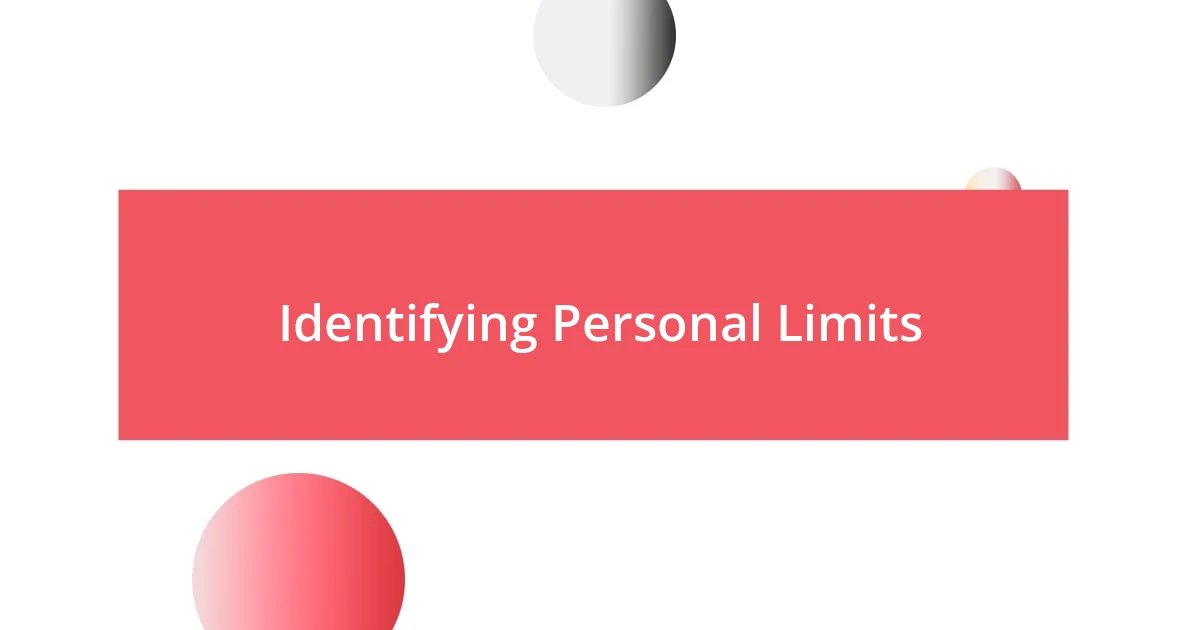Key takeaways:
- Establishing boundaries is vital for mental and emotional well-being, as it allows individuals to prioritize their needs and foster healthier relationships.
- Effectively communicating boundaries requires clarity, kindness, and consistency, which contributes to mutual respect and understanding in relationships.
- Boundaries are dynamic and may need adjustments over time to respond to changing circumstances and maintain a healthy balance between personal well-being and connection with others.

Understanding the Need for Boundaries
Boundaries are essential for maintaining our mental and emotional well-being. I can recall a time when I felt overwhelmed by others’ demands, realizing that I had neglected my own needs. It dawned on me—how can I be there for them if I’m empty myself?
Have you ever felt drained after spending time with someone, even if they didn’t intend to be taxing? For me, it was often a close friend whose constant neediness left me exhausted. Setting clear boundaries not only protected my energy but also allowed our friendship to flourish as it encouraged healthier interactions.
Understanding boundaries means recognizing that saying “no” isn’t selfish; it’s a form of self-care. When I learned to assert my limits, I noticed an unexpected shift in my relationships. It felt liberating to honor my preferences, creating space for the connections that genuinely uplifted me.

Identifying Personal Limits
Identifying personal limits can sometimes feel daunting, but I’ve found it to be an eye-opening experience. For instance, I remember the moment I realized that my time and energy were finite resources—like a reservoir that could run dry if overextended. Reflecting on my daily routines helped me pinpoint activities that drained my energy versus those that replenished it. Have you ever noticed how certain commitments leave you feeling exhilarated while others deplete your spirit? For me, volunteering was revitalizing, but attending certain social events often left me wanting to retreat.
To identify my limits, I began to engage in regular self-reflection. Journaling became my go-to method, allowing me to process my emotions and recognize patterns in my interactions. I might reflect on how I felt after various encounters and ask myself questions like, “What did I really enjoy about that?” or “What could I do without?” This practice highlighted my essential boundaries, helping me discern what I could, and could not, tolerate without losing myself in the process.
One strategy that worked for me was keeping a “daily energy tracker.” I documented my feelings after different activities for a week. It was revealing to see that my energy dipped significantly after particular obligations. Over time, this allowed me to establish essential limits around my availability and emotional investments. It’s really fascinating how tuning into our feelings can illuminate the personal guidelines we need to feel our best.
| Activities That Rejuvenate Me | Activities That Drain Me |
|---|---|
| Volunteering | Crowded Parties |
| Nature Walks | Extended Meetings |
| Time with Close Friends | Unplanned Social Outings |

Communicating Your Boundaries Effectively
When it comes to communicating your boundaries, clarity is paramount. I remember a specific conversation with a colleague that changed everything for me. I hesitated for a moment, but I finally said, “I need uninterrupted time to focus on my project, so I won’t be available for the next few hours.” It felt a bit nerve-wracking at first, but the relief that washed over me confirmed I was on the right track. You see, clear communication removes ambiguity and helps others understand where I stand.
Here are a few key strategies I’ve learned to effectively communicate my boundaries:
– Be Direct but Kind: Use simple and clear language. Phrasing like “I would prefer if…” or “I cannot take on any more work right now” sets a firm yet respectful tone.
– Use “I” Statements: This keeps the focus on your feelings rather than blaming others, making it easier for them to understand your perspective.
– Practice Active Listening: After stating your boundaries, give the other person space to express their feelings. This encourages constructive dialogue.
– Stay Consistent: Once I’ve set a boundary, I stick to it. This consistency not only reinforces my limits but also teaches others to respect them.
– Adjust as Needed: Sometimes, it’s necessary to revisit boundaries and communicate adjustments. Life changes, and I’ve found that flexibility can be healthy.
Reflecting on these moments has reminded me that healthy boundaries enrich my life. By establishing clarity in communication, I’ve seen my relationships thrive, proving that kindness and firmness can coexist beautifully.

Setting Boundaries in Relationships
Setting boundaries in relationships isn’t just about keeping others at bay; it centers on fostering an emotionally healthy environment for everyone involved. I recall a time when a close friend frequently interrupted my personal time to discuss her dilemmas. It felt overwhelming. One day, I gathered the courage to say, “I love being there for you, but I need time alone to recharge. Can we schedule a call instead?” In that moment, I realized that not only did I clarify my needs, but I also strengthened our friendship by encouraging mutual respect for each other’s space.
The emotional relief that came after speaking my truth was profound. Have you ever felt that weight lift off your shoulders after you’ve expressed what you’ve been holding in? I can’t stress enough how important it is to share your boundaries with those you care about. It’s like drawing a line in the sand that defines what feels safe and healthy for you. When I openly communicated my need for alone time, it underscored my commitment not just to my own wellbeing but also to the quality of our interactions.
When I think about how setting boundaries has transformed my relationships, I feel a sense of empowerment. It’s about mutual respect, understanding, and ultimately, love. Each relationship is unique, and by establishing what feels comfortable for me, I invite others to express their needs too. Isn’t it wonderful when we create a space for authentic connections to flourish? In the end, taking the time to articulate boundaries is not just an act of self-care; it is an invitation for growth and deeper understanding within our relationships.

Managing Reactions from Others
Managing reactions from others can be quite the balancing act. I vividly remember a time when I set a boundary with a family member who was accustomed to relying on me for advice. When I gently explained that I needed some time to focus on my own priorities, the initial shock on their face was hard to miss. It struck me how hard it can be for loved ones to adjust when our boundaries shift. I wondered, “Will they understand?” But taking that step taught me the value of establishing healthy dynamics, even if it takes time for everyone to recalibrate.
Sometimes, the reactions I received were not what I expected. One friend responded with anger, feeling rejected by my newfound limits. I felt a pang of guilt—was I being too harsh? However, I realized that not everyone would appreciate boundaries at first. It’s a part of the process that allows for growth. Have you ever faced backlash when trying to uphold your limits? The rollercoaster of emotions—doubt, guilt, and ultimately, resilience—taught me that maintaining my boundaries is not just beneficial for me, but also creates a space where others can learn about respect and mutual understanding.
Over time, I discovered that some people genuinely adapt and even appreciate the new boundaries. I recall a colleague who initially viewed my insistence on focused work time as standoffish but later expressed gratitude for the clarity it brought to our working relationship. Isn’t it refreshing when boundaries pave the way for healthier exchanges? Navigating these reactions is a journey. Each interaction reinforces the importance of staying true to myself, regardless of how others may initially respond.

Maintaining Boundaries Over Time
Maintaining healthy boundaries over time requires consistent effort and self-reflection. I remember a phase when I noticed people around me slipping back into old habits, ignoring the boundaries I had set. It felt frustrating, but I learned that keeping boundaries means regularly reaffirming them. Just the other day, a friend assumed we could go back to our previous level of closeness, disregarding my need for personal space. I found myself saying, “I appreciate your eagerness, but I still need that time for myself. Let’s reconnect in a few weeks.” It felt empowering to stay firm, even when there was pressure to compromise.
There are moments when maintaining my boundaries can feel like a tug-of-war. I’ve encountered situations where a loved one would challenge my limits, perhaps not out of malice but simply out of habit. When this happens, I take a breath and remind myself, “It’s okay to stand my ground.” I once had a colleague who frequently interrupted my projects with casual chats. I had to communicate that while I enjoyed our chats, they needed to happen during designated breaks—something I did respectfully, yet firmly. How often do we hesitate to express our needs due to fear of conflict? I’ve learned that clear communication actually fosters stronger relationships.
Over time, I’ve seen boundaries adapt and transform as situations change. Reflecting on my journey, I’m often amazed at how some relationships have flourished. A family member who once struggled with my limits now respects and even supports them. It’s heartwarming to realize that open dialogue can lead to deeper connections. I often ponder, “What if everyone viewed boundaries as acts of love instead of barriers?” For me, this perspective shift has been crucial; maintaining boundaries is not just about keeping people at bay, but about allowing meaningful relationships to grow in a healthy way.

Adjusting Boundaries as Needed
Adjusting my boundaries as needed has been a significant part of my growth. There was a time when I realized that some limits I had set felt too rigid in a new context. For example, I had established a strict “no phone calls after 8 PM” rule to protect my evenings. However, when a close friend faced a personal crisis, I found myself re-evaluating that boundary. I opted to have a candid conversation, saying, “I usually need that time to unwind, but I want to be there for you now.” This flexibility not only deepened my connection with my friend but also helped me see boundaries as dynamic rather than fixed.
I’ve also faced moments where I needed to tighten boundaries that had become too porous. After a season of saying “yes” to every social gathering, I found myself overwhelmed and drained. I vividly recall the moment I realized this wasn’t sustainable during a particularly busy week; I had to step back and reassess. I began communicating my needs more clearly, often saying, “I love spending time with you all, but I need to prioritize my rest.” It’s interesting how people often respond positively when they see that we’re prioritizing our well-being. Have you ever surprised yourself by how well others understood your need for change?
As I reflect, it’s clear that the ability to adjust my boundaries has fostered a healthier and more balanced lifestyle. Each adjustment acts like a tune-up for my emotional wellbeing, ensuring I’m in tune with my own needs while still supporting those around me. I’ve learned that these boundaries can be a conversation, not a confrontation—an ongoing discussion rather than a definitive set of rules. What experiences have shaped your understanding of healthy boundaries? By sharing and reflecting on these interactions, we can cultivate richer, more resilient relationships together.















